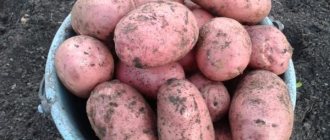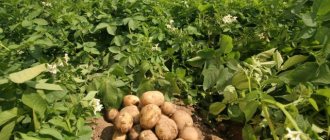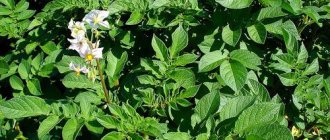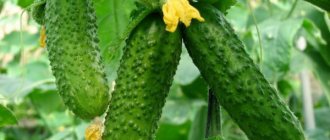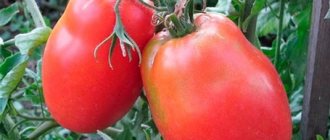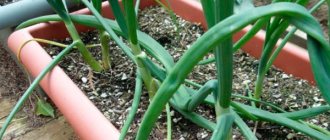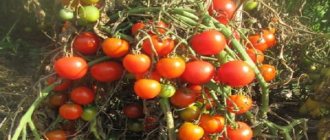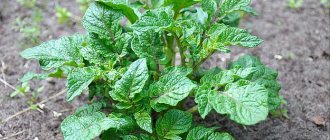The history of the origin of the “Spring” potato variety
The “Vesna” variety was bred by employees of the Leningrad Research Institute of Agriculture, LLC SF “Liga” (Russia).
Entered into the State Register in 1994.
The table below presents data on the yield of other potato varieties:
| Name | Variety | Productivity |
| Nikulinsky | Late ripening | From 170 to 300 centners per hectare. |
| Cardinal | Late ripening | From 200 to 350 centners of potatoes are harvested from 1 hectare. |
| Rocco | Late ripening | From 350 to 400 centners per hectare. |
| Kiwi | Late ripening | From 1 kg of planting tubers it reaches 20 kg. |
| Picasso | Late ripening | From 1 hectare about 20 tons. |
| Borovichok | Early ripening | 200-250 centners per 1 hectare of land. |
| Elmundo | Early ripening | 250-350 centners per hectare. |
| Felox | Early ripening | 250 centners per hectare. |
| Bellarosa | Early ripening | The harvest from one bush is 8-10 tubers. |
| Natasha | Early ripening | From 130 to 190 centners per hectare. |
| Forty days | Extra early | Up to 300 centners of potatoes are harvested from one hectare of soil. |
| Karatop | Extra early | From 18.5 to 27 tons per hectare (Middle Volga region), from 20 to 43.5 tons per hectare (Northwestern region). The maximum yield is 50 tons per hectare. |
| Riviera | Extra early | After the first digging on the 45th day after the emergence of potato shoots, it ranges from 134 to 225 centners per hectare. The maximum yield by the end of the growing season reaches 450 centners per hectare. |
| Zhukovsky early | Extra early | The harvest from one bush is up to 15 tubers. |
| Minerva | Extra early | Fertile soils allow you to harvest the first harvest of up to 230 centners per hectare. By the end of the growing season (45-50 days), the maximum yield is achieved - up to 430 centners per hectare. |
| Crane | Mid-late | 640 centners per hectare. |
| Sorcerer | Mid-late | Productivity varies from 27 to 35 tons per hectare. |
| Mozart | Mid-late | The average yield is approximately 430 c/ha. |
| Grenada | Mid-late | From one hectare you can harvest up to 60 tons of potatoes. |
| Ramona | Mid-late | The yield is consistently average from 10 to 15 tons per hectare. |
| Yanka | Mid-early | The average yield ranges from 195 to 315 centners per hectare. |
| Giant | Mid-early | The average harvest ranges from 290 to 424 centners per hectare. |
| Tuscany | Mid-early | Productivity varies from 210 to 400 centners per hectare. |
| Purple Haze | Mid-early | Productivity varies from 182 to 309 centners per hectare. |
| Santana | Mid-early | The average yield varies from 164 to 384 centners per hectare. |
Zoned for cultivation in:
- Volgo-Vyatka;
- Ural;
- East Siberian;
- Far Eastern regions.
Correct fit
To increase productivity, you need to follow the following rules for growing in your garden plots:
- Planting material is planted in beds where perennial grasses, winter crops and legumes grew;
- For planting, give preference to pure-grade tubers, whose weight is 50-100 grams, after high-quality pre-planting preparation;
- After the tubers have warmed up, as a preventative measure, treat the planting material with a solution of copper sulfate (1 tsp per three liters of water);
- Choose a well-lit area, which, immediately before planting, is dug to the depth of one spade bayonet, then loosen the soil using a rake;
- It is not recommended to apply fresh manure; use high-quality humus as a replacement;
- To eliminate rust on potato tubers, it is necessary to carry out root feeding of the plantings at the rate of 3 tbsp. l. superphosphate per bucket of water;
- The optimal temperature for potatoes to grow and develop normally is from +18 to +22 °C.
REFERENCE: Any temperature fluctuations have a negative impact on both the yield and the quality properties of root crops.
Features of cultivation
This variety must be removed from storage 2 weeks before planting in the light; greening has a beneficial effect on germination and further development.
Potatoes cannot be planted in areas where tomatoes were grown last season. You also can’t grow potatoes next to tomatoes; they have common diseases and suffer from common pests.
The best companion for “Ramos” is cabbage and onions, a good place to plant where legumes and grains were planted last year.
When the soil temperature at a depth of 10 cm is about 13 degrees, it is possible to plant potatoes, maintaining a distance between plants of at least 20 cm. “Ramos” intensively develops many tubers, so the distance between potato bushes should be as large as possible.
Planting of mid-early potatoes begins in early May. The air temperature should not be less than 18 degrees; Ramos does not like hot temperatures. “Ramos” does not favor heavily moist areas; use dry places or elevated areas for cultivation.
In hot climates, potatoes are threatened by aphids, spider mites, cicadas, Colorado potato beetles and their larvae, mole crickets and wireworms. Insecticides or non-toxic biological preparations, which are generously sprayed on the plantings, will help get rid of pests.
On our website you will find a lot of useful information about spraying potatoes to prevent pests.
You will also find articles about folk remedies and chemical preparations against the Colorado potato beetle.
ATTENTION! “Ramos” reacts poorly to substances contained in anti-weed preparations and cannot be used after sprouts appear. It is better to use mulching.
"Ramos" responds well to root feeding and spraying with fertilizers
Regular loosening, hilling and weeding are required. Watering is not necessary. To form a good harvest, you can pick off the flowers from the bushes, all the growth will go into the tubers. It is necessary to dig up potatoes exactly at the time of technical maturity due to poor resistance to late blight of tubers
"Ramos" responds well to root feeding and spraying with fertilizers. Regular loosening, hilling and weeding are required. Watering is not necessary. To form a good harvest, you can pick off the flowers from the bushes, all the growth will go into the tubers. It is necessary to dig up potatoes exactly at the time of technical maturity due to poor resistance to late blight of tubers.
The variety is well stored for a long time and is not afraid of frost. To avoid severe germination and spoilage of tubers, it is necessary to store them at a temperature of up to 4 degrees, it must be constant. Storage place: dry, dark.
We also bring to your attention useful information about which sprays and how they will help when growing potatoes.
As well as materials on the use of herbicides and fungicides, their benefits and harm to plants.
Harvesting
Drying potato tops (in mid-July) indicate the final growing season of the variety. The skin of the tubers becomes denser. Existing harvesting methods:
- Traditional. The potato bush is pulled out and the tubers remaining in the ground are selected;
- Protracted. Large tubers are torn from the bush, and the bush itself is left to grow, which allows small root crops to ripen. After two to three weeks, small tubers will double their mass.
Elite potato varieties:
Diseases and pests
The obvious advantages of the Vesna variety include the high immunity of this vegetable plant to many diseases characteristic of other potato varieties:
- potato cancer;
- macrosporiosis;
- viral diseases;
- late blight.
To prevent the occurrence of diseases in this variety, it is recommended to carry out some preventive measures:
- plant only healthy planting material;
- treat potato bushes during flowering and again after three weeks with biological preparations;
- leaves and stems damaged by pests and diseases should be removed in a timely manner;
- plant mustard, horseradish, garlic, and lemon balm in the rows, the aroma of which repels pests.
GOOD TO KNOW!
"Prestige" against the Colorado potato beetle for processing potatoes
Reviews about the variety
Table potatoes of the “Spring” variety, which have high marketability, form pink and white root crops. They are used to prepare soups, salads and main courses. The Vesna variety is popular in Russia because it guarantees a harvest of marketable tubers two months after planting. Potatoes respond well to fertilizing with organic and mineral fertilizers.
REFERENCE: Planting tubers in compacted soil significantly reduces yield.
Potatoes of the “Spring” variety will be an excellent choice both for growing on personal plots and on an industrial scale. It is successfully grown by gardeners to get an early harvest of young potatoes and sell them on the market. Vesna potatoes are productive; good care of the plantings helps produce up to 1.5 kg of marketable potato tubers from one bush.
We invite you to familiarize yourself with potato varieties that have different ripening periods:
| Late ripening | Early ripening | Very early | Mid-late | Mid-early |
| Nikulinsky | Borovichok | Forty days | Crane | Yanka |
| Cardinal | Elmundo | Karatop | Sorcerer | Giant |
| Rocco | Felox | Riviera | Mozart | Tuscany |
| Kiwi | Bellarosa | Zhukovsky early | Grenada | Purple Haze |
| Ivan da Marya | Natasha | Farmer | Melody | Openwork |
| Picasso | Ariel | Minerva | Margarita | Santana |
| Asterix | Queen Anne | Veneta | Ramona | Desiree |
| Slav | Arosa | Kiranda | Dolphin | Lady Claire |
Characteristic
The Explosive potato variety has round or oval tubers. The tough skin is reddish-pink, with a warm palette of light tones. The eyes are medium-sized, small and of medium depth. The shades of the dense and juicy pulp are cream or yellowish. From 8 to 14 tubers are formed in the nest, almost identical in size. The average weight of the Vzryvny potato fruit, according to the description of the variety in official sources, is 110-150 g. The yield for early varieties is high, reaching up to 450-500 c/ha if the crop care requirements are met.
Note! The tubers are formed for harvesting after 42-50 days of plant development, which is a valuable feature of the Vzryvnoy variety. Full ripening occurs in 60-70 days. Early potato variety is responsive to timely enrichment of soil with organic matter
Therefore, they plant the Explosion potato in a plot prepared in the fall, in which case it lives up to its glib name. The marketable yield of early ripening products is 93%, this is a very high figure, at the level of well-known foreign varieties
The early potato variety is responsive to timely enrichment of the soil with organic matter. Therefore, they plant the Explosion potato in a plot prepared in the fall, in which case it lives up to its glib name. The marketable yield of early ripening products is 93%, this is a very high figure, at the level of well-known foreign varieties
Full ripening occurs in 60-70 days. The early potato variety is responsive to timely enrichment of the soil with organic matter. Therefore, they plant the Explosion potato in a plot prepared in the fall, in which case it lives up to its glib name. The commercial yield of early ripening products is 93%, this is a very high figure, at the level of well-known foreign varieties.
Potato tubers Explosion with excellent taste, rich in starch, which is determined in the range from 16 to 22%
The content of this substance, important for the structure of cooked potatoes, depends on the availability of fertilizers and moisture:
- the larger the area with the crop was fed, the less starch, which cannot be formed quickly in early varieties;
- in the dry season, the tubers are much richer in starch than in the rainy summer.
Tubers of the Vzryv variety belong to the culinary type CD according to the international classification, which has the following characteristics:
- boilability;
- mealiness;
- lack of wateriness.
Thanks to their dense skin, varietal potato tubers are resistant to mechanical damage and are suitable for mechanized harvesting. They are well stored, their shelf life rises to 95%, which meets modern requirements for the quality of commercial products.
The shape of the tubers is round or oval
Although the variety was tested in areas of the Central region of Russia, in accordance with the official description of the Vzryv potato, it is suitable for cultivation in all areas where potatoes are planted. Another valuable feature of the variety is its high adaptability to any soil, as well as to climatic variations.
Important! The variety is drought-resistant and tolerates long periods without additional moisture, although with watering the yield increases significantly. The creators of the new variety of early potatoes took care to select plants that are resistant to a number of characteristic diseases: The creators of the new variety of early potatoes took care to select plants that are resistant to a number of characteristic diseases:
The creators of the new variety of early potatoes took care to select plants that are resistant to a number of characteristic diseases:
- potato cancer;
- late blight of tubers and tops;
- common scab.
Note! The variety is susceptible to viral infections; gardeners should take note of this. Periodic phyto-cleaning of varietal plantings is recommended. A big plus for potato-growing summer residents is that the Vzryv variety resists infection with the golden cyst nematode
A big plus for potato-growing summer residents is that the Vzryv variety resists infection with the golden cyst nematode
Periodic phyto-cleaning of varietal plantings is recommended. A big plus for potato-growing summer residents is that the Vzryv variety resists infection with the golden cyst nematode.
